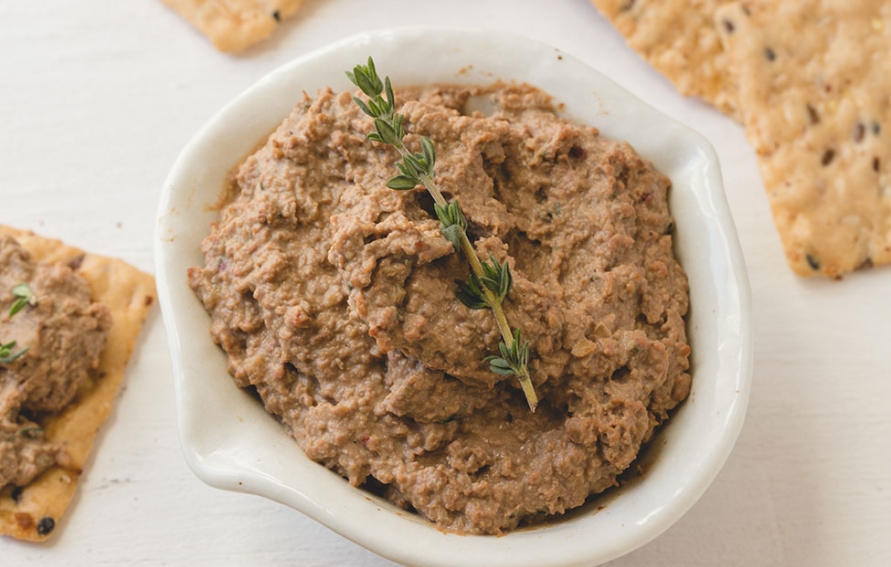About this recipe
Pâté is cashmere for the palate. Smooth, rich and decadent, it seems more sinful than it is. Pâté is almost always thought of in the context of sophisticated French cuisine, but versions of pâté are cranked out by casual home cooks in country kitchens all over France and haute temples to gastronomy in Paris alike. Both are delicious—the slightly more humble, peasant version is consumed with as much gusto, and probably much more frequently, in France than the more elevated, technically proficient version.
The best part is that conscientious carnivores can indulge in chicken liver pâté without a glimmer of guilt—unlike foie gras, which often maligns the simple French repast simply by association.
Brady Duhame, executive chef at the shamelessly haute but incredibly approachable and user-friendly dining destination 15 Church in Saratoga Springs, offers the classic recipe at three speeds: beginner, intermediate and advanced. The easiest version will produce a pâté reminiscent of bistro-style pâtés in France with a slightly rougher texture, while the intermediate will be more refined and the advanced officially Escoffier-approved haute.
Instructions
CHICKEN LIVER PATE – 3 SPEEDS
Recipes offered by Chef Bradley Duhame of 15 Church in Saratoga Springs.
For Novices:
Chicken Liver Pâté
This savory pâté is thought to have its roots in ancient Greece, thousands of years ago, when butchers sold pâtés at markets, another delicious innovation nose-to-tail eating can be credited with.
Makes 12 servings
2 pounds (preferably organic) chicken livers
2 tablespoons unsalted butter
1 cup thinly sliced shallots
¼ cup thinly sliced garlic
Salt and pepper to taste
⅛ to ¼ cup canola oil
⅓ cup sherry vinegar
¾ cup Madeira wine
¾ cup cream
1½ tablespoons chopped fresh thyme
Clean livers by removing veins and fat and washing in water then drying between paper towels.
Melt butter over low heat in large sauté pan. Add shallots and garlic and sauté with some salt and pepper until just tender. Remove from pan.
In large sauté pan, heat oil over low heat. Add livers in small batches and sauté until slightly brown. Add shallots/garlic mix and sauté for 1 minute, deglaze with vinegar and Madeira, then reduce by half. Add cream and thyme, then reduce until you achieve a creamy consistency. Season to taste.
Cool, then puree in food processor.
Serve with toasted baguette with cornichons on the side and your favorite marmalade or mostarda (quince is my favorite this time of year).
Intermediate:
Chicken Liver Pâté
Casual bistros, take-out counters and gourmet restaurants in France all offer several versions of chicken liver pâté that vary by season, and preparation techniques are passed down in their individual families and villages.
Makes 12 servings
Follow instructions for novice recipe. Once pureed in food processor, pass pâté mixture through a fine sieve (chinois). Serve in medium-size bowl with condiments of choice with an option of grinding fresh black pepper over the pâté and adding some chopped chives.
Serve with toasted baguette or Parker House rolls with cornichons on the side and your favorite marmalade.
Advanced:
Chicken Liver Pâté
The French chef Marie Antoine Careme (1784-1833) was one of the early pâté promoters in haute cuisine, but Auguste Escoffier (1846–1935) is credited with popularizing it.
Makes 12 servings
Follow instructions for novice recipe. Once pureed in food processor, pass pâté mixture through a fine sieve (chinois).
Once passed through sieve, place pâté in piping bag and pipe into a small to medium clear dish and layer with quince chutney and chives and repeat three more times.
Serve with toasted baguette, or the chef’s favorite, homemade Parker House rolls with cornichons on the side and your favorite marmalade or mostarda; quince is the chef’s favorite this time of year—recipe included below.
Quince Chutney
This quince chutney can be paired with grilled chicken and pork roasts, too. A dab on buttered rice is a revelation.
Makes 1 quart
3 quince about 9 ounces each, peeled and cut into large dice
4½ cups sugar
3 to 4 teaspoons fresh ginger, minced fine
2¼ cups apple cider vinegar
Water to fill 2 inches above quince
¼ cup lemon juice
Take quince, sugar, ginger, apple cider vinegar and water and place all in a nonreactive pot. Bring to simmer and continue simmering for up to 3 hours, stirring often, or until quince is cooked through and the mixture is thick and resembles chutney.
Season with lemon juice, blend with food processor, and cool.




